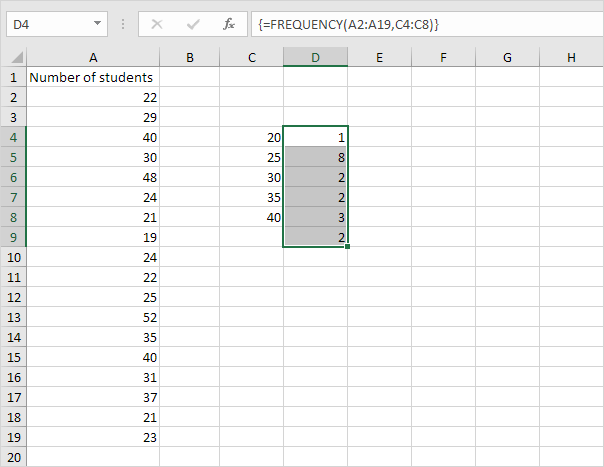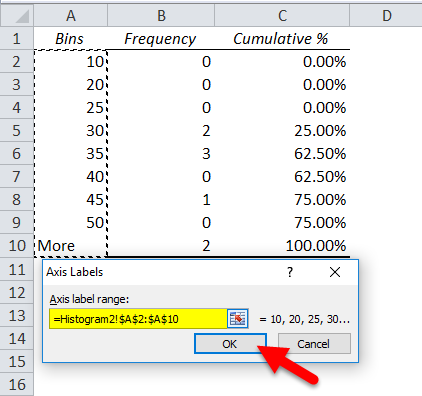

The following rules must be completed in order to create an ungrouped frequency distribution (“Psychological statistics. There are two types of frequency distributions: Grouped and Ungrouped (“Psychological statistics. Still we may not be so surprised by the result as we may if the H side appears 18 times.A set of data can be described with a frequency distribution.

Suppose that out of the 20 times tossing, we get 13 times occurrence of H side. If the coin is fair, it is more expectable that the H side appears 10 times than it does 18 times. Furthermore, the probability of H side appearing 18 times is much smaller than 10 times appearing. Statistically speaking, the probability that the H side appears 18 times is very small. If the coin is fair indeed, we expect that the frequency of occurrence of each side is around 10. It is unlikely, but not totally impossible. Why? Although we know that it can happen by chance, it happens very rarely. If it turned out that the Head (H) side appeared 18 times out of the 20 times of tossing, we would possibly be surprised. The word fair here means that each side of the coin has the equal probability of appearing. Class Boundaries Each class has a lower class boundary (LCB) and an upper class boundarySharePost a CommentRead more BINOMIAL DISTRIBUTIONOctober 20, 2019Suppose that a fair coin is tossed 20 times. LCL of class #2 is 10 minutes and the UCL is 14 minutes, etc. LCL of class #1 is 5 minutes and the UCL is 9 minutes. Each class has a lower class limit (LCL) and an upper class limit (UCL). Class Limits There are five classes in Table 1. For example, there are 3 conversations whose duration is between 5 and 9 minutes, 5 conversations whose duration is between 10 and 14 minutes, etc. The frequencies in the table indicate how many conversations fall in each category/class. The class interval of the first class is 5 - 9 minutes, the class interval of the second class is 10 - 14 minutes, etc. Each class is assigned to a symbol called class interval. There are five classes (or categories) for the duration. Table 1 shows the duration of 20 conversations. Here is a typical frequency distribution table (FDT). ShareShare ANATOMY OF FREQUENCY DISTRIBUTION TABLESAugust 30, 2019Quantitative data can be presented in the form of frequency distribution tables. Apply the Sturges rule in determining the number of classes. The data are presented as follows.īased on the data, create a frequency distribution table with equal class widths. Referring to the example above, create the frequency distribution tables based on the other two alternatives of grouping.Ī researcher has collected some data on the distance (in kilometers) from people's residence in a certain district to the nearest newsstand. Assuming we choose the last alternative among the three alternatives of grouping mentioned above, we get the following frequency distribution table. In other words, we find the class frequencies in this step. Step 5: Determine the number of observations falling into each class interval No matter which one we choose as set of class intervals, make sure that each of the original data can be classified into one and only one (interval) class in the grouping. Continuing this way, we will have the following list of class intervals.Īlternatively, we may construct other class intervals such as: Then, the second class must be 252 - 261. Step 4: Determine the class intervals of each classĪs the smallest data in this example is 242 and the class width (as determined above) is 10, we may determine that the first class interval is 242 - 251. As the original data are whole numbers, the c value must be a whole number. To find c, use $c = \frac \approx 9.2857$. $k = 1 + 3.322 \: log \: 40 \approx 6.32$Īs the value of k must be a natural number, 6.32 is rounded up to 7, so k = 7. Step 2: Determine the number of categories/classes (k)Īpplying Sturges rule (k = 1 + 3,322 log n, where n = the number of data), we have: The range (R) is defined as the difference between the largest data and the smallest data. To construct a frequency distribution table of the ungrouped data, apply the following steps. Suppose we have a collection of ungrouped data on last years advertising expenditures of 40 logistics companies, recorded in millions Rupiahs.
HOW TO CONSTRUCT A FREQUENCY DISTRIBUTION TABLE ON EXCEL HOW TO
Now we are learning how to create a frequency distribution table. Below is an example of frequency distribution table. The frequency distribution table is a table that divides data into groups (classes) and shows how many data values occur in each group/class.



 0 kommentar(er)
0 kommentar(er)
